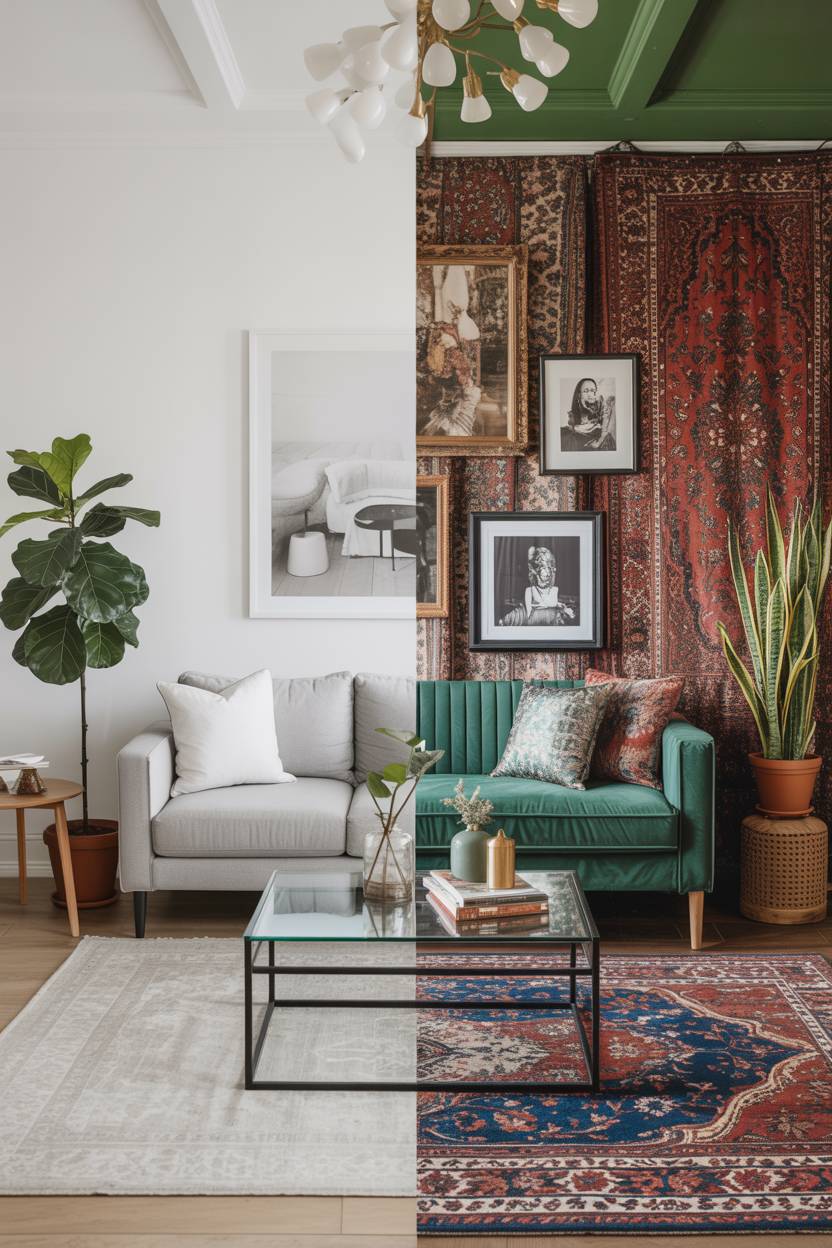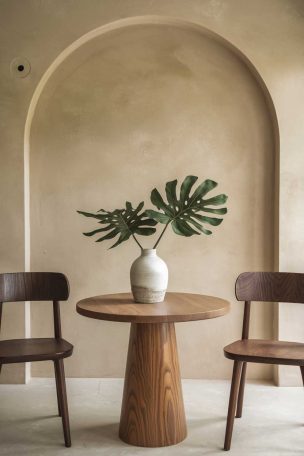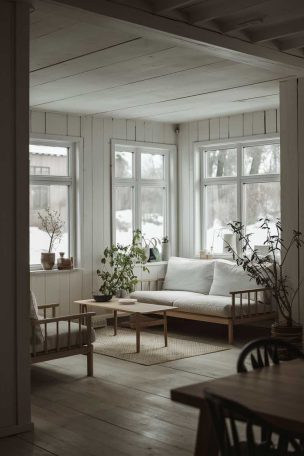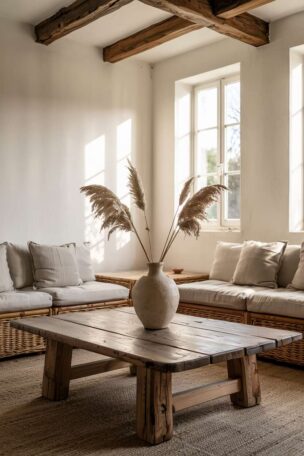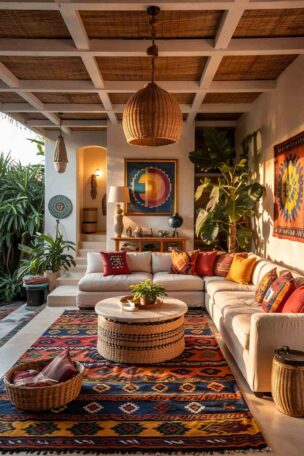Your home tells your story. Some people speak in whispers—clean lines, open spaces, and quiet elegance. Others prefer to shout with joy—bold colors, rich textures, and rooms filled with treasures. This is the heart of minimalism vs maximalism in interior design.
Neither approach is right nor wrong. They’re simply different languages for expressing who you are. Minimalism interior design celebrates the beauty of less, while maximalist interior design embraces the richness of more.
Your perfect space might live somewhere between these two worlds.
Understanding Minimalism in Interior Design
Minimalism interior design isn’t about having empty rooms. It’s about intentional choices. Every piece of furniture serves a purpose. Every color has meaning. Every object earns its place.
This design philosophy grew from the idea that our spaces should calm us, not overwhelm us. When you remove the excess, what remains becomes more powerful. A single piece of art on a white wall commands attention in ways that fifty pieces cannot.
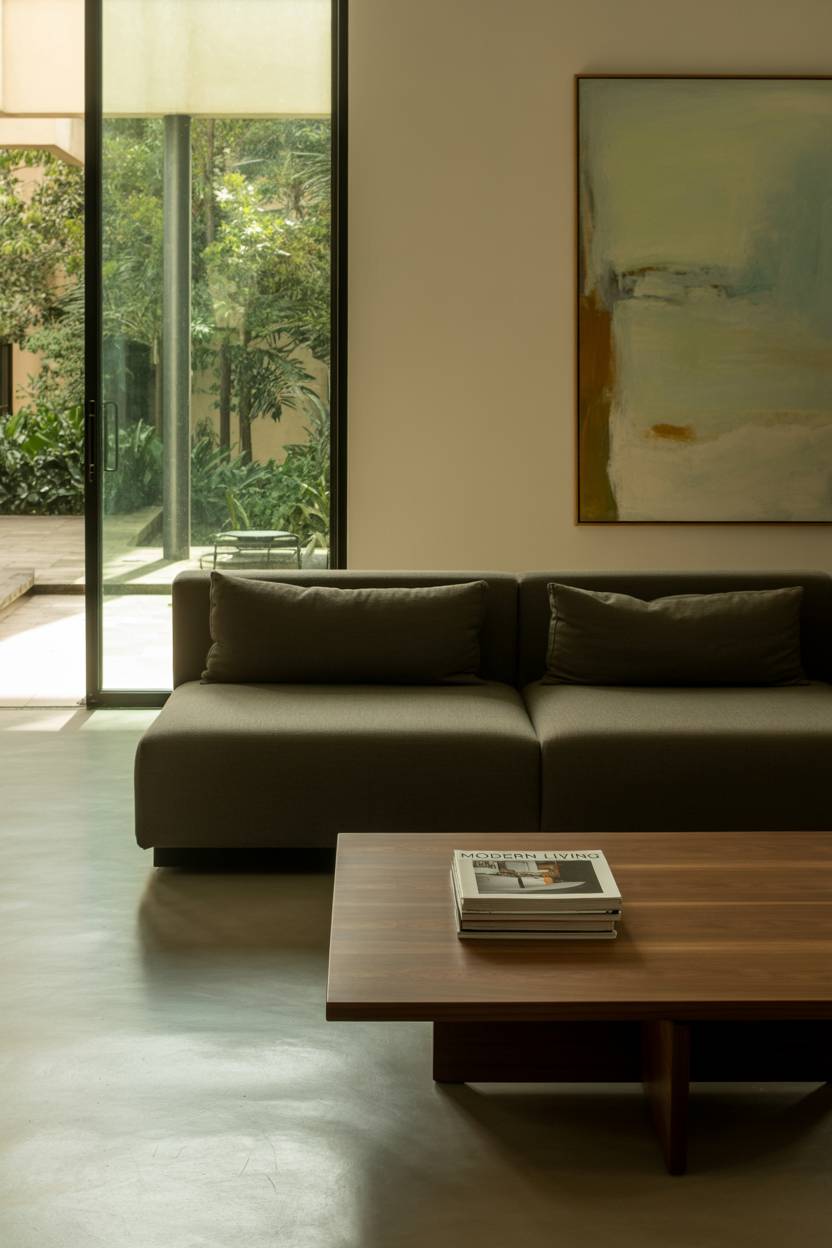
Core Principles of Minimalist Decor
Minimalism decor follows clear rules. Clean lines replace ornate details. Geometric shapes take precedence over flowing curves. Furniture sits low to the ground, creating horizontal emphasis that makes rooms feel wider and more peaceful.
Color plays a supporting role, never the star. Whites, grays, and beiges dominate the palette. These neutral tones reflect light beautifully, making spaces feel larger than their actual square footage. When color appears, it does so sparingly—perhaps a single navy accent wall or warm wood tones.
Function drives every decision. Sofas provide comfortable seating without unnecessary decorative elements. Tables offer surface space with sleek, unadorned legs. Storage solutions hide clutter behind smooth cabinet doors.
Open floor plans amplify the minimalist effect. Walls disappear where possible, creating flowing spaces that breathe. Negative space becomes as important as the furniture itself. This emptiness isn’t vacant—it’s full of possibility and calm.
Quality trumps quantity every time. One beautiful, well-made sofa outshines three mediocre pieces. Investment pieces last longer and bring more satisfaction than rooms filled with temporary solutions.
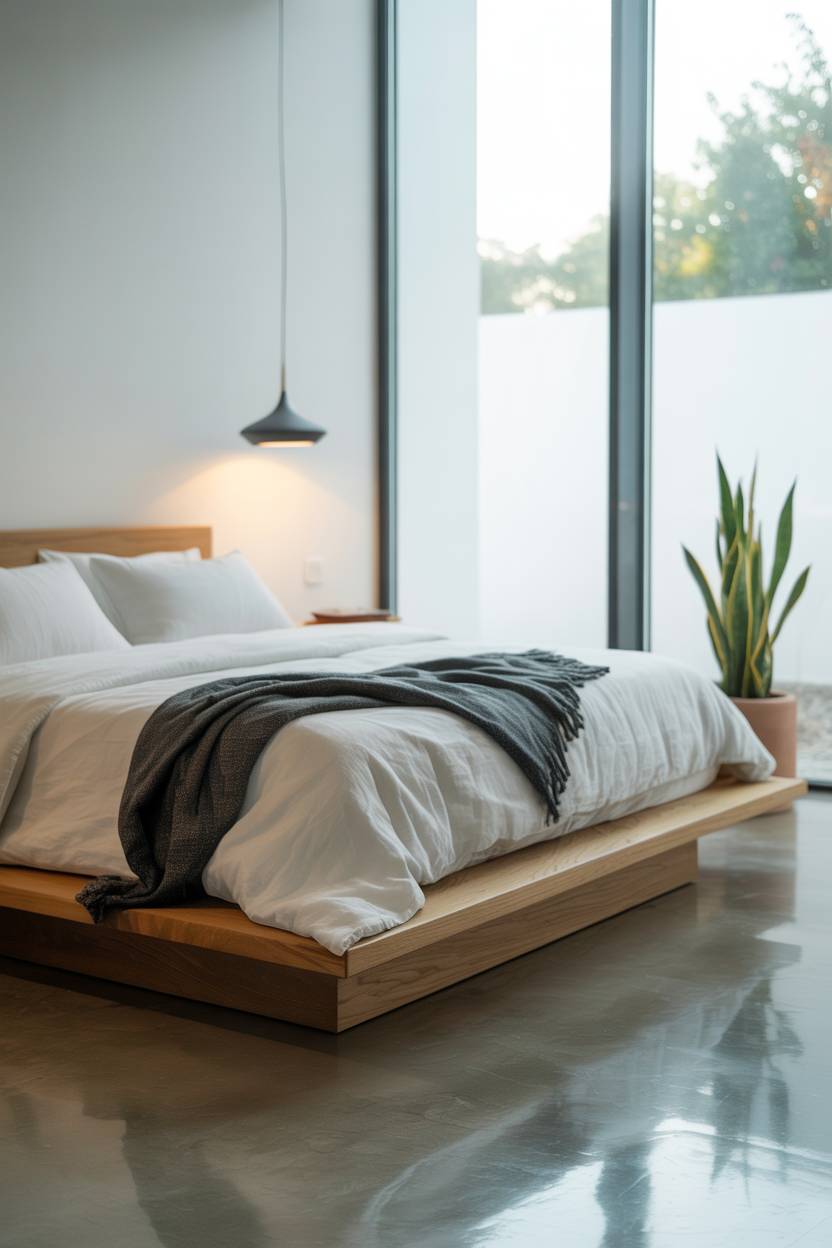
Benefits of Minimalism Interior Design
Minimalism interior design creates instant calm. Busy minds find peace in uncluttered spaces. Visual distractions disappear, allowing you to focus on what matters most. Stress levels drop when your environment supports rather than overwhelms you.
Small spaces benefit tremendously from minimalist principles. Removing visual clutter makes rooms appear larger. Light bounces freely between surfaces. Your eye travels unobstructed from one end of the room to the other.
Maintenance becomes effortless. Fewer objects mean less dusting. Simple surfaces wipe clean quickly. Hidden storage systems keep necessary items organized but out of sight.
Decision fatigue vanishes when options are limited. Your curated wardrobe hangs in a streamlined closet. Morning routines flow smoothly when everything has its designated place.
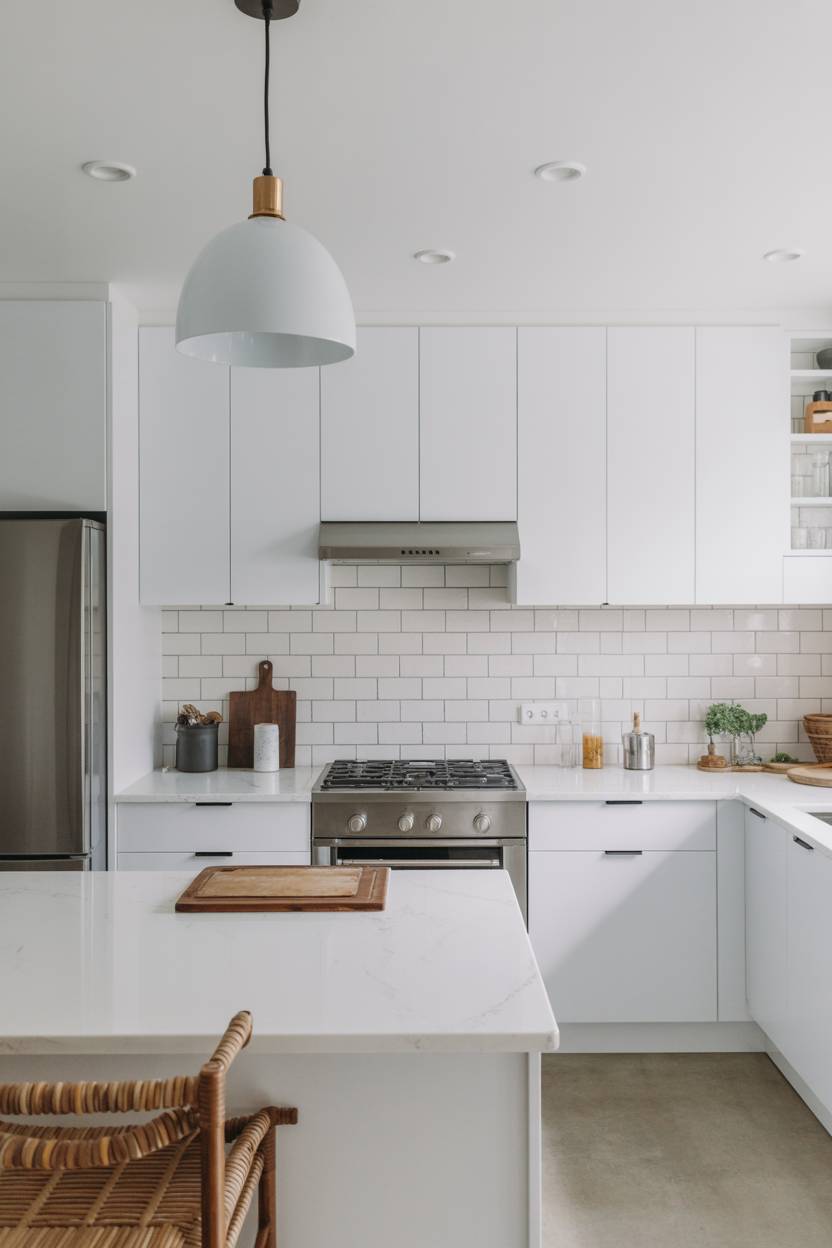
Common Minimalism Design Elements
Sleek furniture defines minimalist spaces. Platform beds sit close to the ground. Sofas feature straight arms and low backs. Dining tables showcase beautiful wood grain without ornate legs or decorative details.
Artwork makes powerful statements through simplicity. One large piece creates more impact than several small ones. Black and white photography complements neutral walls. Abstract pieces in muted tones add visual interest without overwhelming the space.
Natural materials bring warmth to minimalist rooms. Light woods like oak and maple add texture without pattern. Stone surfaces provide subtle variation in color and grain. Metal accents in brushed finishes catch light beautifully.
Window treatments stay simple. Roller blinds in white or light gray offer privacy without detracting from the decor. Sheer curtains filter light gently. Many minimalist spaces opt for minimal window coverings, celebrating natural light.
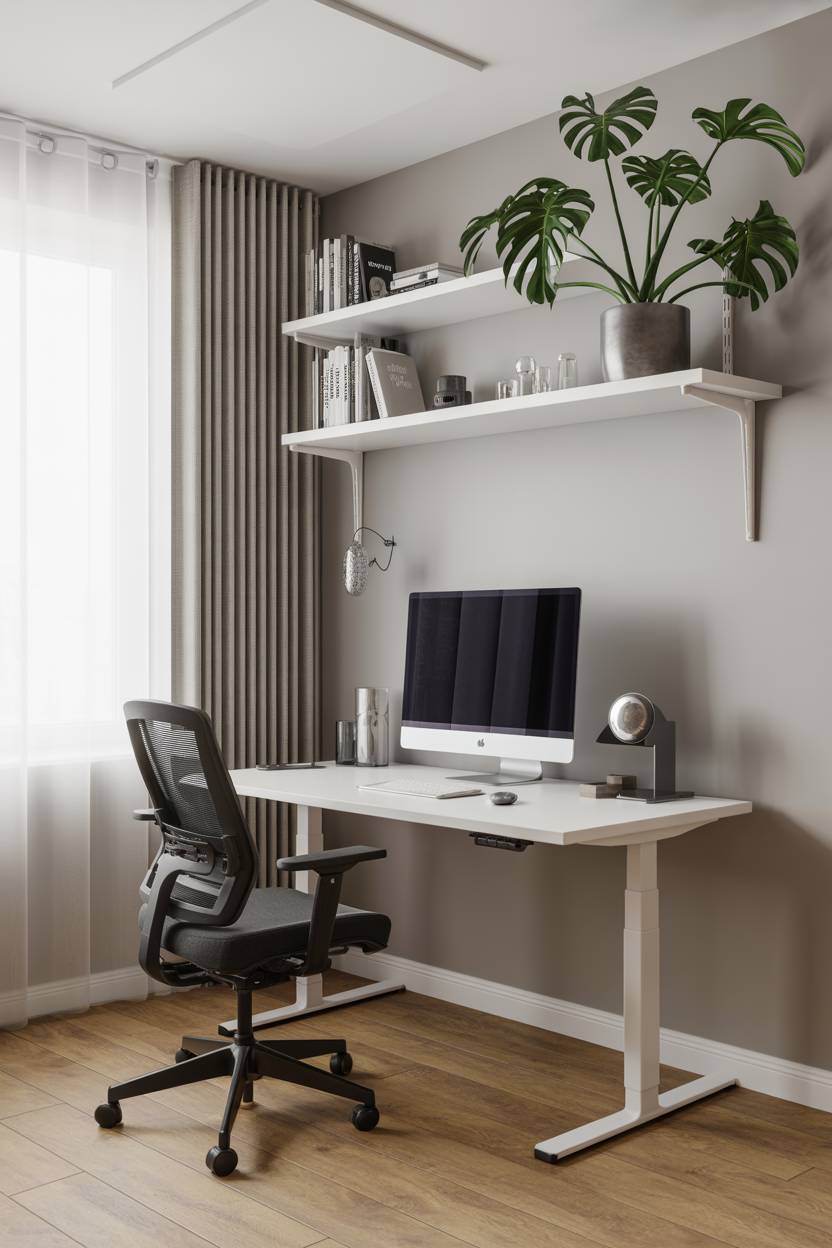
Storage solutions hide in plain sight. Built-in cabinets blend seamlessly with the walls. Ottoman storage serves dual purposes. Under-bed drawers keep linens organized but invisible.
Exploring Maximalism in Interior Design
Maximalist interior design celebrates abundance. More colors, more patterns, more textures, more personality. This approach sees empty walls as missed opportunities and neutral colors as boring choices.
Maximalist decor tells stories through objects. Each piece has meaning—a vintage chair from your grandmother, artwork from travels, books that shaped your thinking. Your space becomes a curated museum of your life experiences.
This design philosophy embraces contradiction. Vintage mixes with modern. Patterns clash beautifully with other patterns. Formal elements sit comfortably next to casual pieces. The result feels collected over time rather than purchased in one shopping trip.

Defining Maximalism Decor Philosophy
Maximalism decor follows the “more is more” philosophy. If one pillow looks good, three might look better. A single piece of art seems lonely—why not create a gallery wall that tells multiple stories?
Color takes center stage in maximalist spaces. Jewel tones like emerald, sapphire, and ruby create rich backdrops. Warm oranges and deep purples energize rooms. Gold accents add luxury and warmth.
Pattern mixing becomes an art form. Florals dance with stripes. Geometric prints complement organic shapes. The key lies in finding common colors that tie different patterns together.
Layering creates depth and interest. Rugs layer over rugs. Throws a drape over sofas already dressed in patterned pillows. Window treatments combine blinds with curtains in different fabrics.
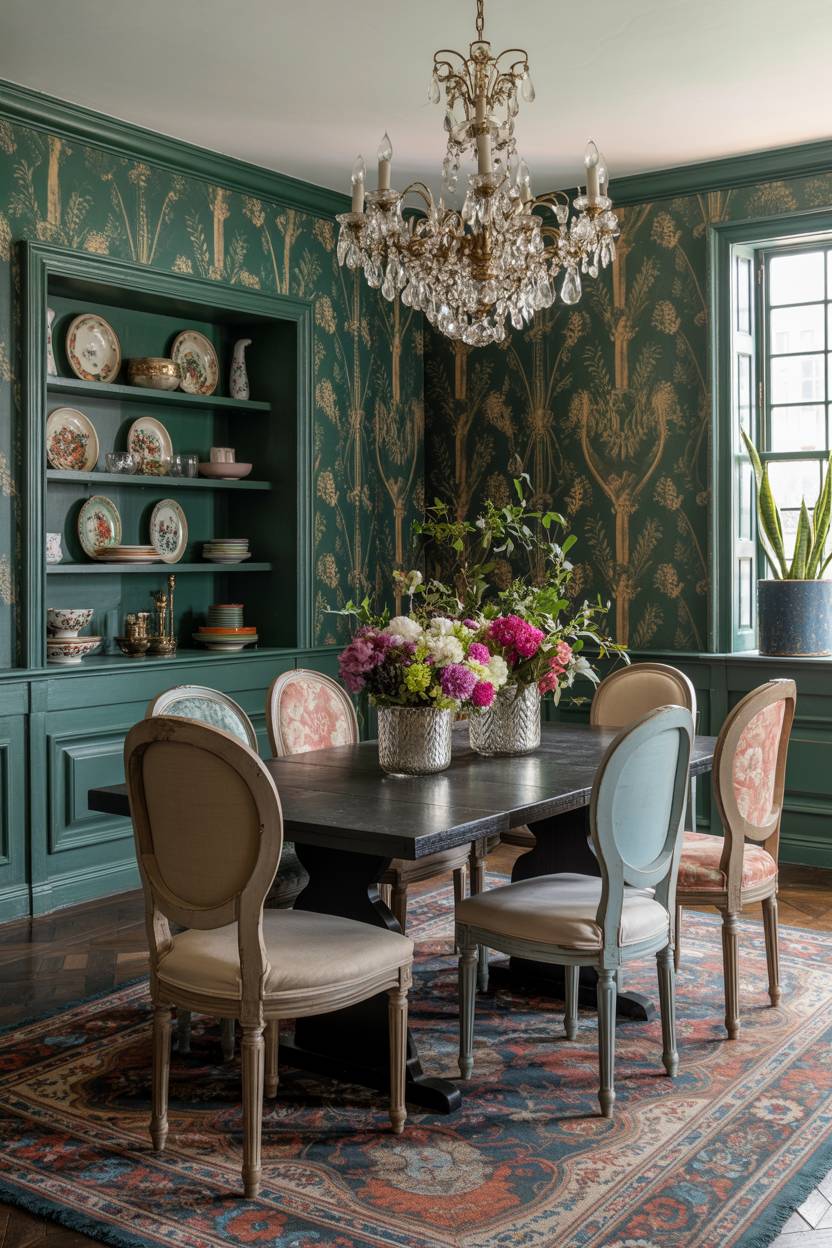
Key Features of Maximalist Interior Design
Rich, saturated colors define maximalist spaces. Deep blues create sophisticated backdrops. Warm terracotta walls invite conversation. Bold color choices reflect confidence and personality.
Multiple lighting sources add warmth and functionality. Table lamps, floor lamps, and pendant lights work together. Chandeliers make dramatic statements. String lights add whimsical touches. Candles create intimate moods.
Gallery walls showcase personal collections. Family photos mix with original artwork. Vintage posters complement modern prints. Mirrors in ornate frames reflect light and expand space visually.
Decorative accessories fill surfaces meaningfully. Coffee table books invite browsing. Ceramic vases hold fresh flowers. Vintage trinkets spark conversations. Each object has earned its place through beauty or sentiment.
Mixed furniture styles create visual interest. Mid-century modern chairs sit at antique dining tables. Contemporary sofas pair with vintage side tables. New pieces blend seamlessly with inherited treasures.
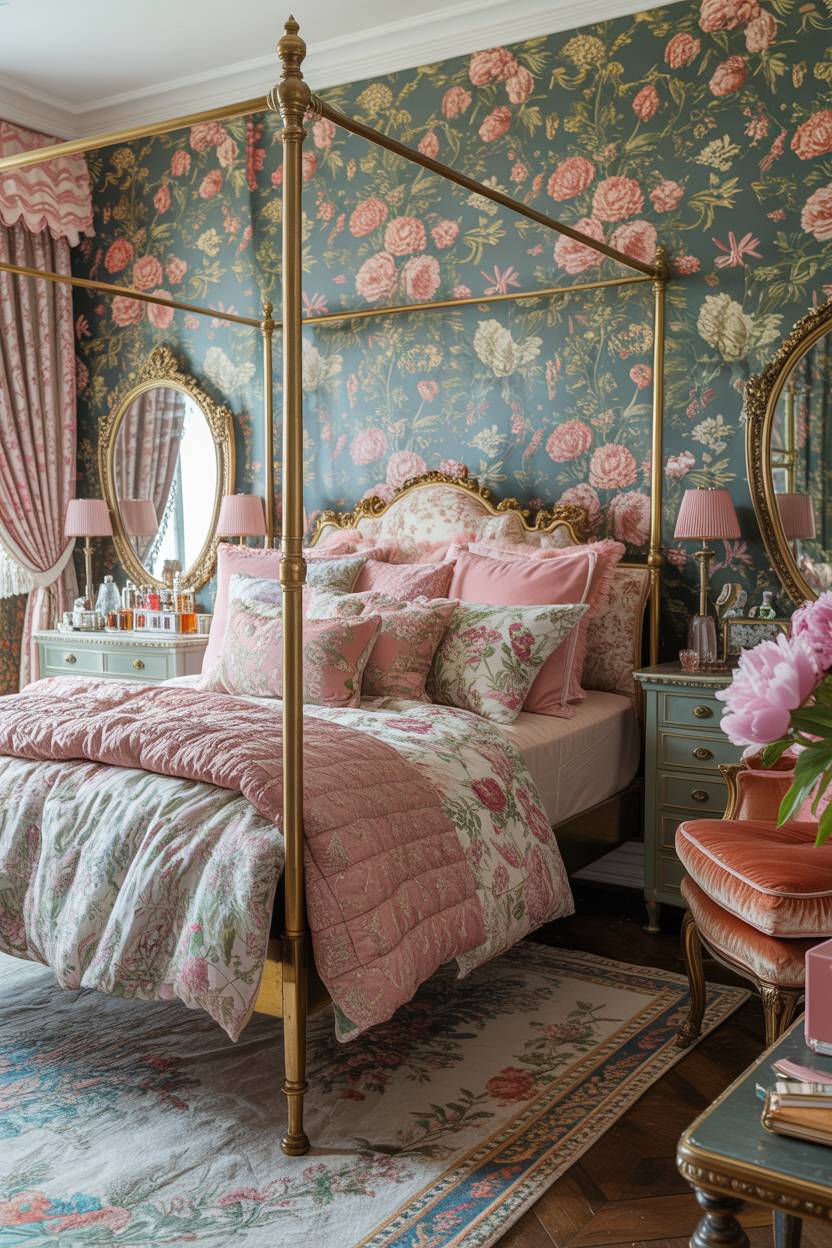
Benefits of Maximalism Decor
Maximalism decor encourages authentic self-expression. Your space reflects your interests, travels, and personality. Guests learn about you simply by looking around your home. Conversations start naturally when surrounded by meaningful objects.
Warm, inviting atmospheres emerge from layered maximalist spaces. Rich colors and soft textures make people want to settle in and stay. Rooms feel lived-in and welcoming rather than showroom-perfect.
Storytelling happens through carefully chosen objects. That ceramic bowl from your trip to Morocco reminds you of adventures. Your grandmother’s quilt adds family history to the bedroom. Books reveal your intellectual interests.
Visual stimulation keeps spaces interesting. Details reward closer inspection. Different seating areas offer varied experiences within the same room. Eyes discover new elements with each visit.
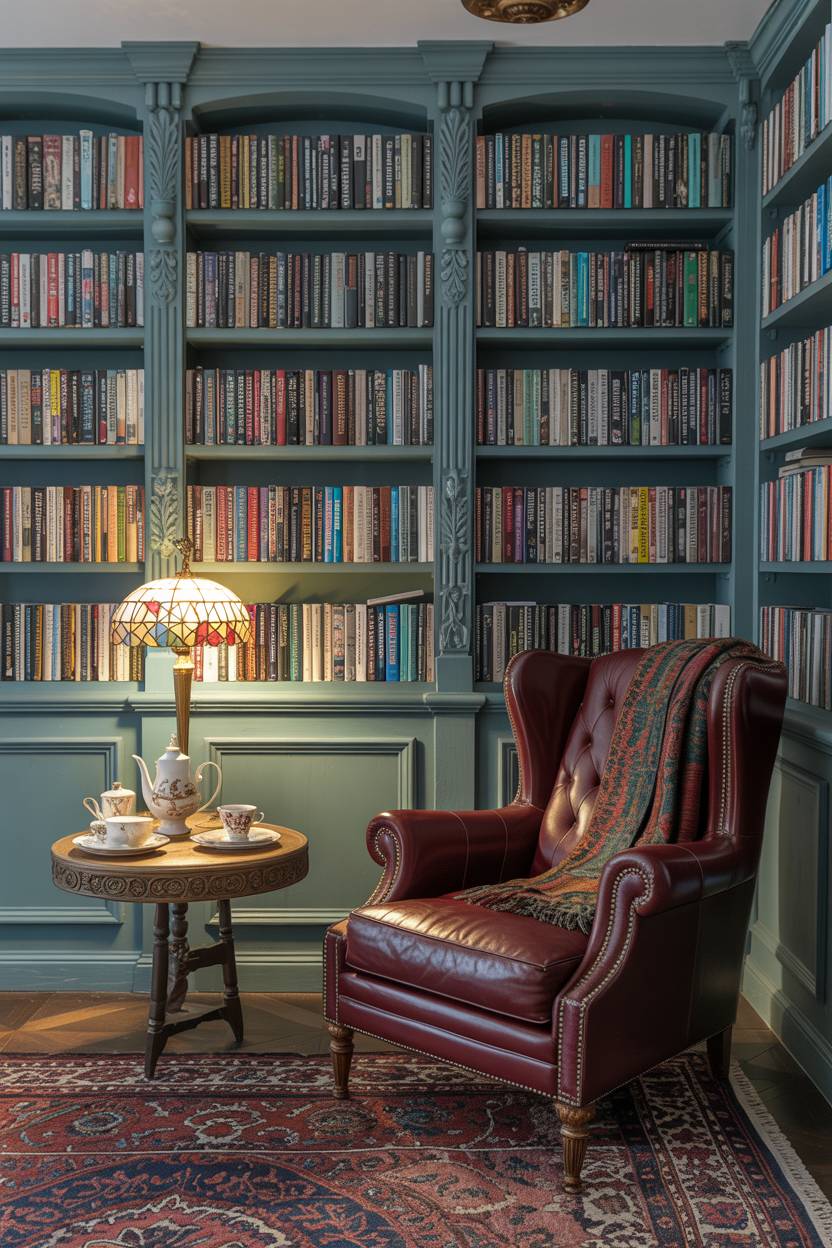
Personal history celebration becomes possible when space allows for collections. Travel souvenirs find homes on shelves. Artwork from different periods of your life coexists peacefully. Maximalist spaces grow and evolve with their owners.
Minimalism vs Maximalism: Direct Comparison
The battle between minimalism vs maximalism plays out in every design decision. These approaches represent opposite ends of the spectrum, each with distinct advantages and considerations.
Understanding the differences helps you identify which approach resonates with your lifestyle and personality. Some people crave the peace of minimalist spaces. Others find energy in maximalist abundance.
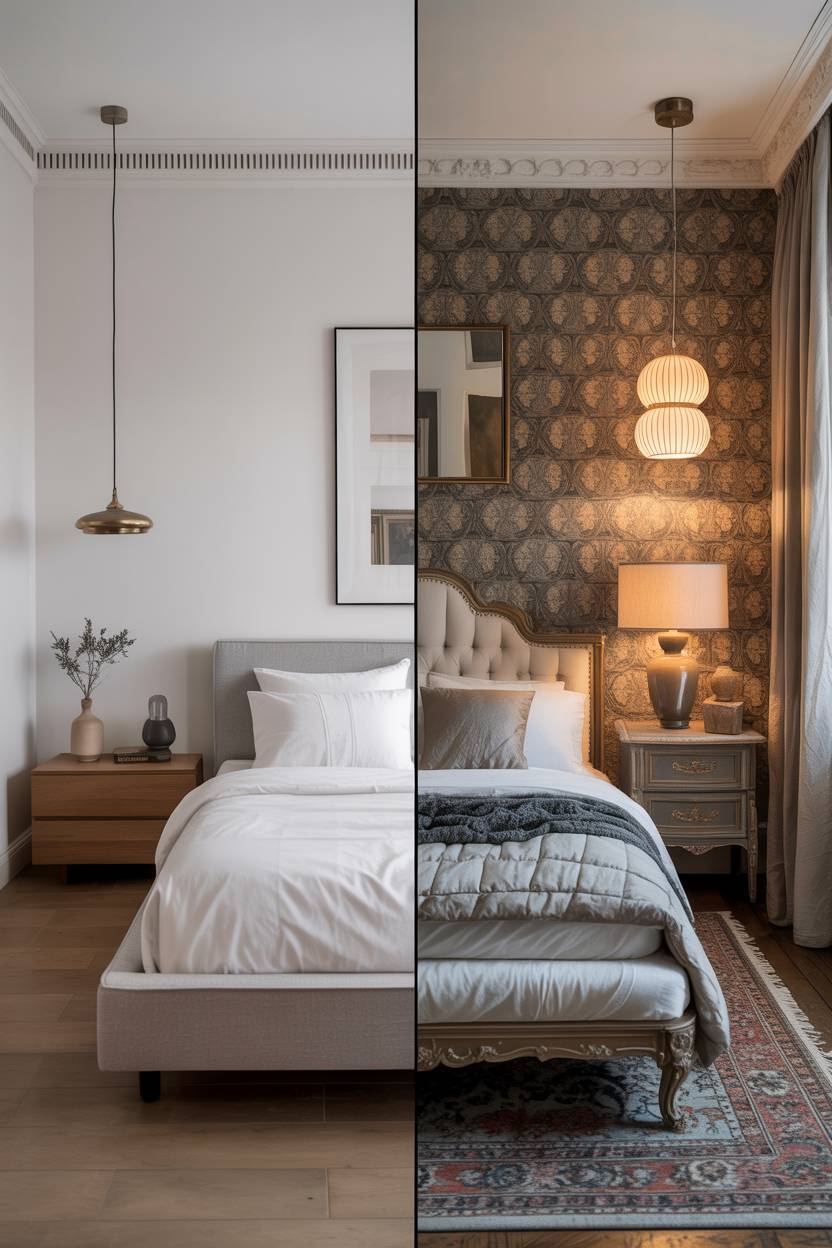
Color Palette Differences
Minimalism interior design relies on neutral, monochromatic schemes. Whites create clean backdrops. Grays add subtle depth. Beiges bring warmth without overwhelming. These colors reflect light beautifully, making spaces feel larger and more peaceful.
Maximalism decor embraces bold, vibrant, contrasting colors. Jewel tones create rich environments. Warm oranges energize spaces. Deep purples add sophistication. Color combinations that seem impossible work beautifully when balanced correctly.
Mood and energy levels shift dramatically between approaches. Neutral minimalist palettes promote calm and focus. Bold maximalist colors stimulate creativity and conversation. Your color choice sets the emotional tone for your entire space.
Lighting considerations vary between styles. Minimalist spaces depend on natural light and simple fixtures. Maximalist rooms layer multiple light sources to highlight colors and textures properly.
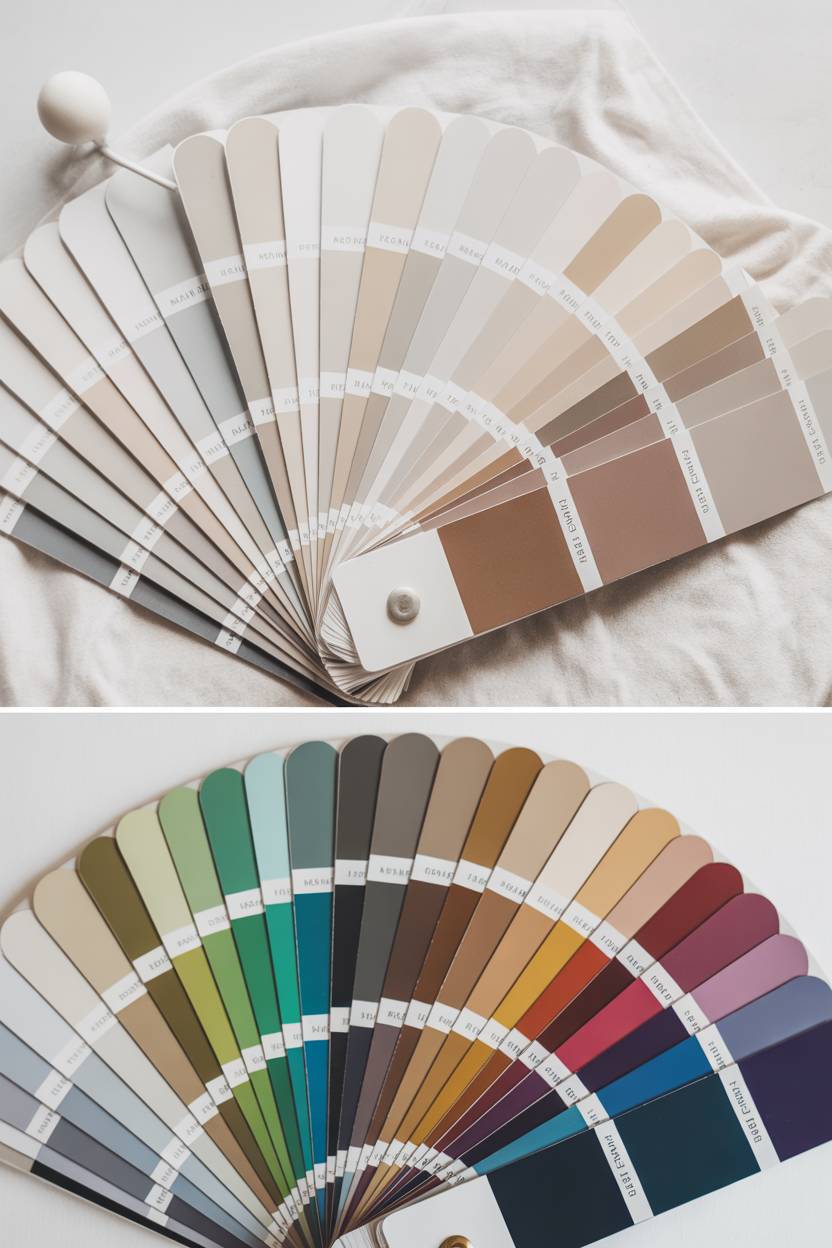
Space Usage Philosophy
Minimalism celebrates open, uncluttered spaces. Furniture floats in rooms with plenty of breathing room. Walking paths stay clear and direct. Negative space becomes as important as furnished areas.
Maximalism creates layered, filled environments. Every corner serves a purpose. Surfaces display meaningful objects. Rooms feel full but organized rather than cluttered.
Furniture arrangement strategies differ significantly. Minimalist spaces feature fewer, larger pieces with simple arrangements. Maximalist rooms combine multiple seating areas and varied furniture scales.
Storage and organization approaches reflect each philosophy. Minimalist spaces hide storage behind clean cabinet doors. Maximalist rooms often display beautiful objects openly while hiding less attractive necessities.
Decorative Elements and Accessories
Minimalism features few, carefully chosen pieces. One beautiful vase makes more impact than several mediocre ones. Accessories serve dual purposes—beautiful and functional.
Maximalism showcases abundant, diverse collections. Gallery walls tell stories through varied artwork. Surfaces display interesting objects that invite closer inspection.
Art and wall decoration differences are striking. Minimalist walls feature single statement pieces or remain bare. Maximalist walls become canvases for personal expression through layered artwork.
Textile and fabric choices reflect each philosophy. Minimalist spaces use solid colors and simple textures. Maximalist rooms layer patterns, colors, and textures for rich visual interest.
Blending Minimalism and Maximalism
The most interesting spaces often combine elements from minimalism vs maximalism. This approach offers the best of both worlds—the calm of minimalist structure with the personality of maximalist details.
Successful blending requires understanding the strengths of each style. Use minimalist principles for the foundation and maximalist touches for personality. This creates spaces that feel both organized and expressive.
Balance becomes the key to success. Too much minimalism feels cold. Too much maximalism feels chaotic. The sweet spot lies somewhere in between, tailored to your specific needs and preferences.
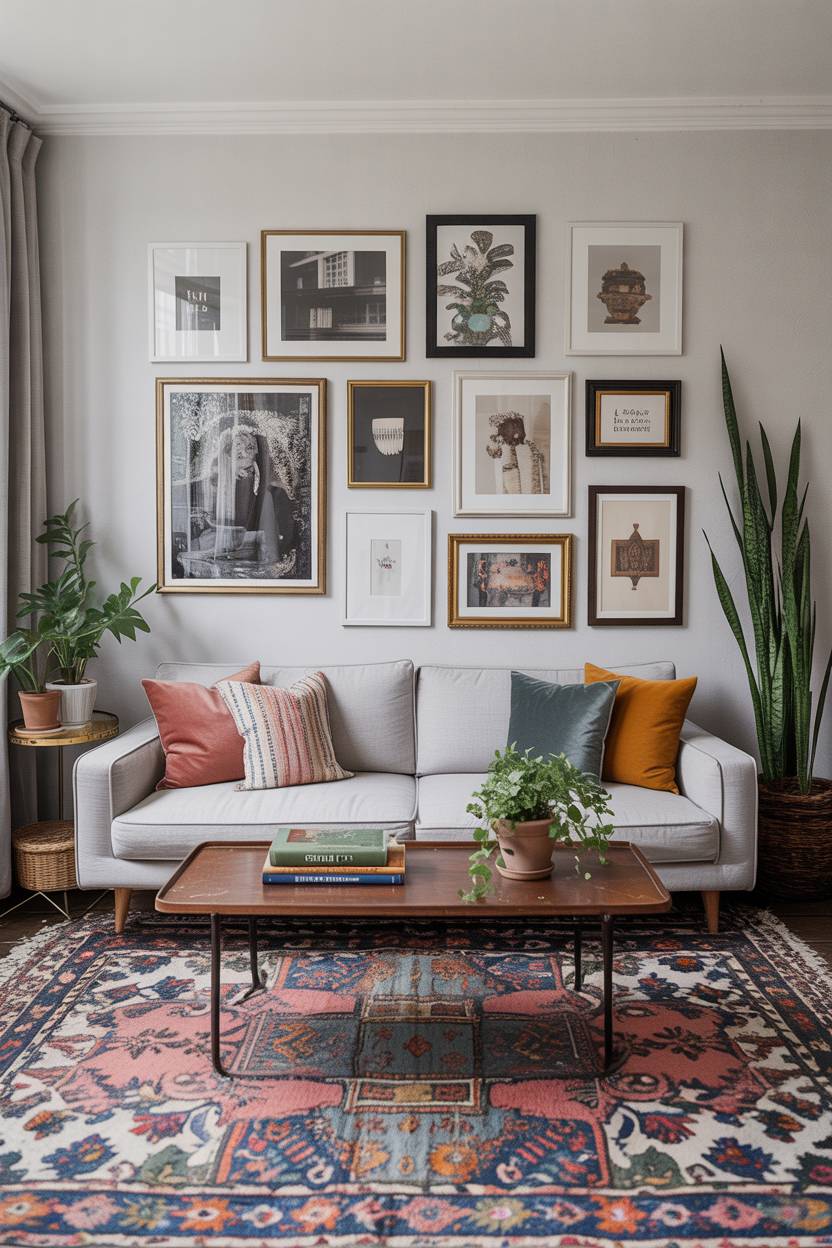
Creating a Neutral Foundation
Starting with minimalist base elements provides stability for maximalist additions. Clean architectural lines create structure. Neutral wall colors offer flexibility for changing accent pieces. Simple furniture pieces anchor rooms without competing for attention.
Choosing anchor colors for cohesion helps unite different elements. Select two or three colors that appear throughout the space in varying proportions. This creates a flow between minimalist and maximalist elements.
Establishing clean architectural lines sets the stage for layered additions. Crown molding, baseboards, and door frames in crisp white create a framework. Built-in storage provides minimalist organization for maximalist collections.
Planning for flexible design additions allows spaces to evolve. Neutral sofas accept changing pillow combinations. Simple lighting fixtures work with added table lamps. Blank walls welcome rotating artwork displays.
Adding Maximalist Accents Strategically
Introducing bold colors through accessories provides impact without overwhelming. Colorful throw pillows transform neutral sofas. Vibrant artwork energizes white walls. Fresh flowers add natural color that changes seasonally.
Layering textures and patterns thoughtfully creates visual interest. Smooth leather chairs pair beautifully with nubby wool throws. Geometric patterns complement organic shapes. Mix scales—large patterns with small ones—for balanced contrast.
Creating focal points with statement pieces draws attention strategically. One bold piece of furniture becomes the room’s star. Dramatic lighting fixtures add personality without cluttering surfaces. Large-scale artwork makes powerful statements on minimalist walls.
Balancing visual weight across rooms prevents spaces from feeling lopsided. Distribute colors, patterns, and textures evenly. Heavy visual elements need lighter counterparts. Dark colors require bright accents for balance.
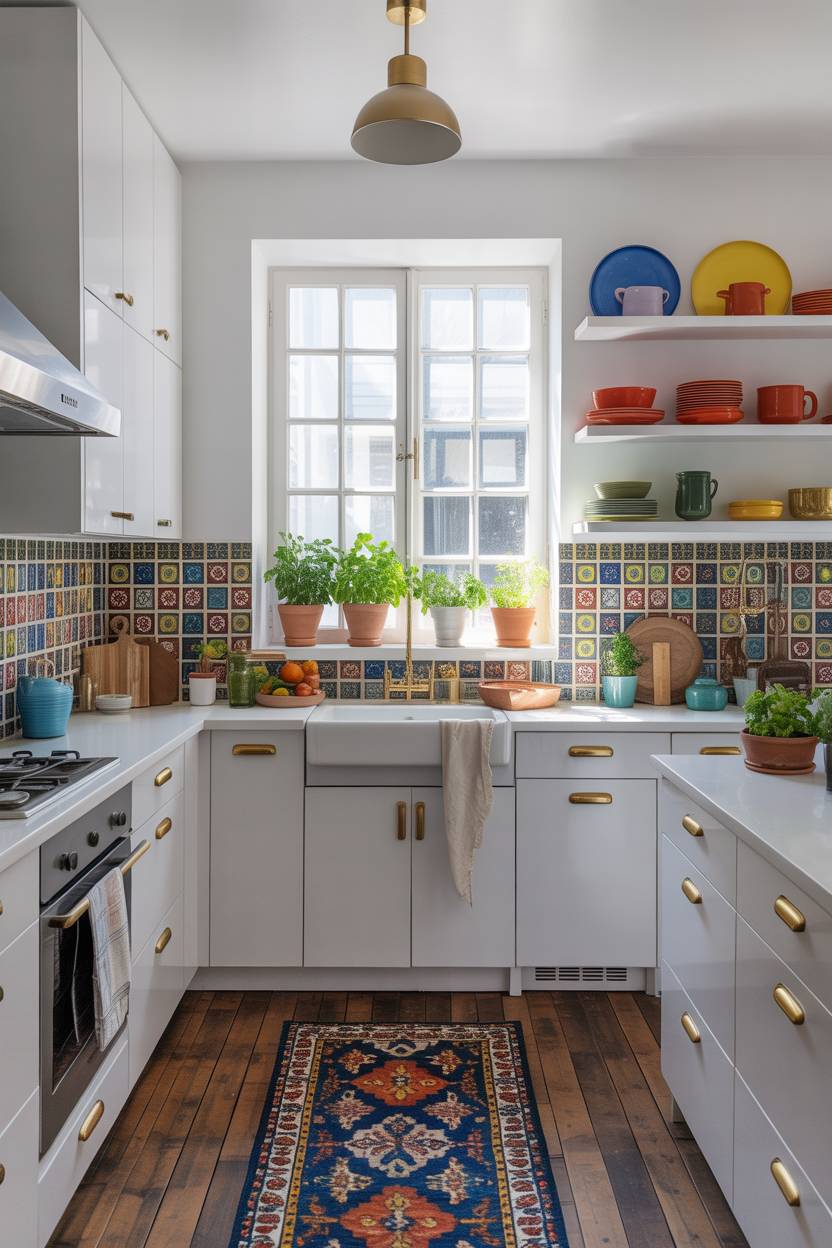
Achieving Visual Harmony
Using the 60-30-10 color rule creates pleasing proportions. Sixty percent neutral base colors provide stability. Thirty percent of secondary colors add interest. Ten percent bold accent colors create excitement without overwhelming.
Maintaining flow between spaces helps homes feel cohesive. Repeat colors and materials throughout different rooms. Carry accent colors from room to room in varying amounts. This creates a sense of intentional design rather than random decorating.
Mixing materials and finishes adds depth without chaos. Combine warm woods with cool metals. Pair smooth surfaces with textured ones. Natural materials bridge the gap between minimalist and maximalist sensibilities.
Creating rhythm through repetition ties spaces together. Repeat shapes, colors, or patterns in different scales throughout rooms. This creates visual connections that make maximalist elements feel intentional rather than random.
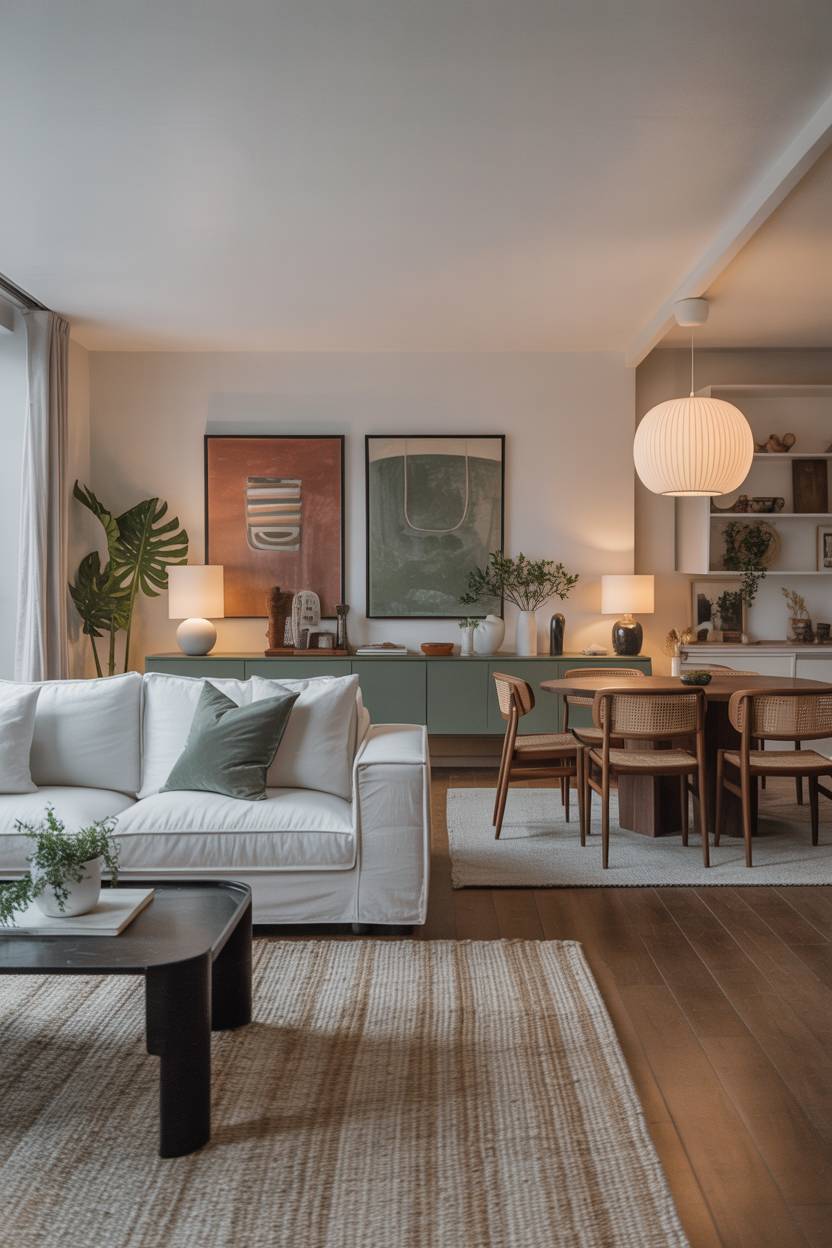
Practical Implementation Tips
Making design decisions becomes easier when you understand your personal preferences and lifestyle needs. Some people thrive in minimalist environments while others need the stimulation of maximalist spaces. Most people fall somewhere in between.
Start by assessing how you live in your space. Do you entertain frequently? Do you work from home? Do you have hobbies that require storage? Your lifestyle should drive your design decisions more than current trends.
Starting Your Design Process
Assessing your lifestyle needs comes first. Families with young children need different solutions from empty nesters. People who work from home require dedicated office spaces. Consider your daily routines when planning room layouts.
Determining your color preferences helps narrow options. Look at your current wardrobe for clues. Notice which colors make you feel energized versus calm. Save images of rooms that appeal to you and analyze common elements.
Evaluating your existing pieces saves money and maintains sentimental connections. Which furniture pieces do you love? What accessories hold special meaning? Build your new design around your favorite existing elements.
Planning your budget and timeline prevents overwhelming decisions. Prioritize which rooms need attention first. Decide which changes require professional help versus DIY efforts. Good design happens gradually, not overnight.
Room-by-Room Applications
Living room design strategies vary between minimalism vs maximalism approaches. Minimalist living rooms feature one seating area with simple, comfortable furniture. Maximalist living rooms might include multiple conversation areas with varied seating options.
Bedroom styling approaches affect sleep quality and daily routines. Minimalist bedrooms promote rest through calm colors and uncluttered surfaces. Maximalist bedrooms can feel cozy and personal when colors remain soothing rather than stimulating.
Kitchen and dining considerations balance function with style. Minimalist kitchens hide appliances and dishes behind seamless cabinets. Maximalist kitchens might display beautiful dishware and colorful accessories openly.
Bathroom design possibilities range from spa-like minimalism to jewel-box maximalism. Consider the room’s size and natural light when choosing your approach. Small bathrooms often benefit from minimalist principles that make them feel larger.
Common Mistakes to Avoid
Overdoing either style extreme creates uncomfortable spaces. Ultra-minimalist rooms can feel cold and unwelcoming. Over-the-top maximalist spaces become visually exhausting. Find the balance that feels right for your personality and lifestyle.
Ignoring functionality for aesthetics leads to daily frustrations. Beautiful rooms that don’t work for your lifestyle become sources of stress rather than joy. Always prioritize how you live over how spaces photograph.
Neglecting lighting considerations affects both mood and functionality. Minimalist spaces need excellent natural light and simple fixtures. Maximalist rooms require layered lighting to highlight colors and textures properly.
Failing to maintain cohesion throughout your home creates jarring transitions. Rooms don’t need to match exactly, but they should feel related. Carry colors, materials, or styles from space to space for flow.
Visual Inspiration Gallery
Great design speaks through images. These examples demonstrate how minimalism vs maximalism can create stunning spaces that reflect different personalities and lifestyles. Each approach offers unique benefits and aesthetic pleasures.
Study these examples to identify elements that appeal to you. Notice how color, lighting, and furniture placement create different moods. Consider how these ideas might translate to your own space and lifestyle needs.
Minimalist Living Spaces
Serene Scandinavian Sanctuary
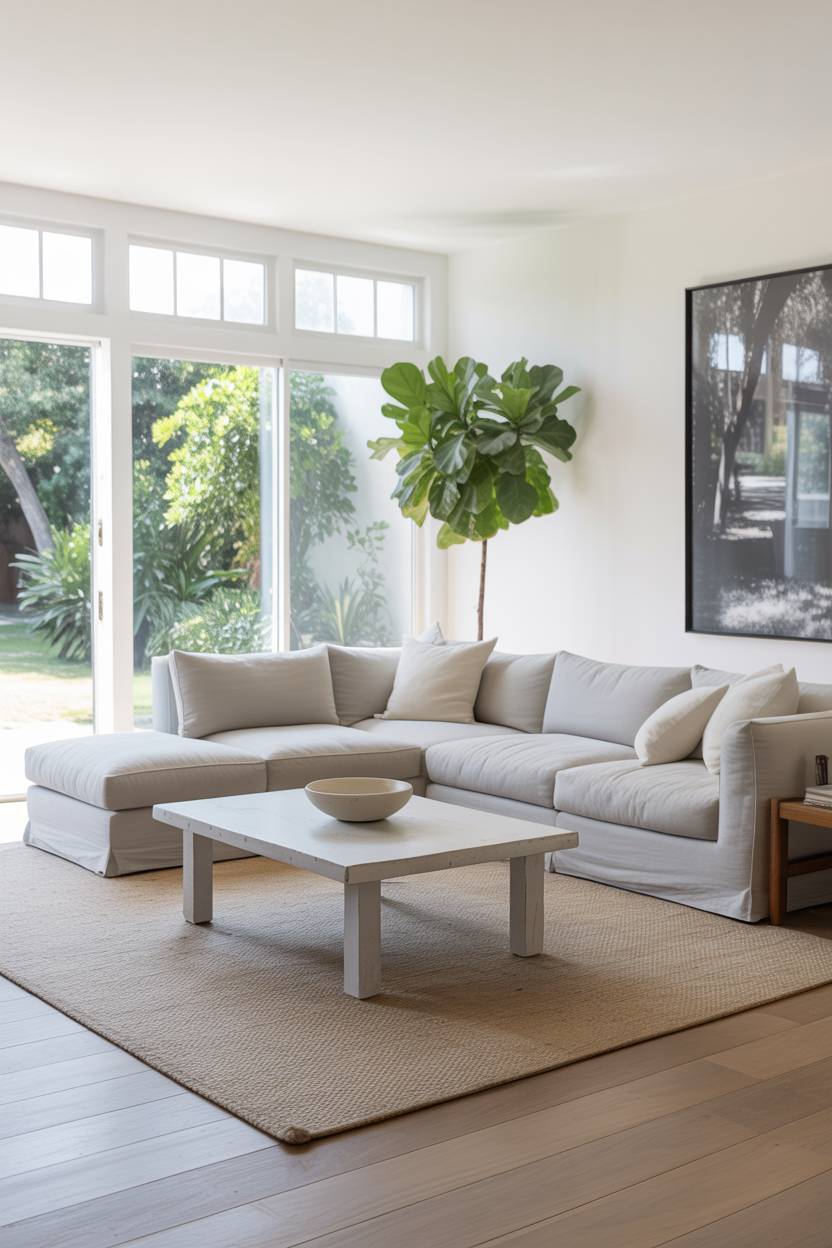
This peaceful minimalist setup demonstrates how less truly becomes more. Natural light streams through unadorned windows, bouncing off white walls and light wood floors. The limited color palette of whites and soft grays creates instant calm.
The beauty lies in the details—the grain of the oak floors, the texture of linen upholstery, the sculptural quality of the single plant. Each element serves multiple purposes: the coffee table provides surface space while showcasing beautiful wood grain, and the plant adds life while creating a natural focal point.
Modern Minimalist Kitchen
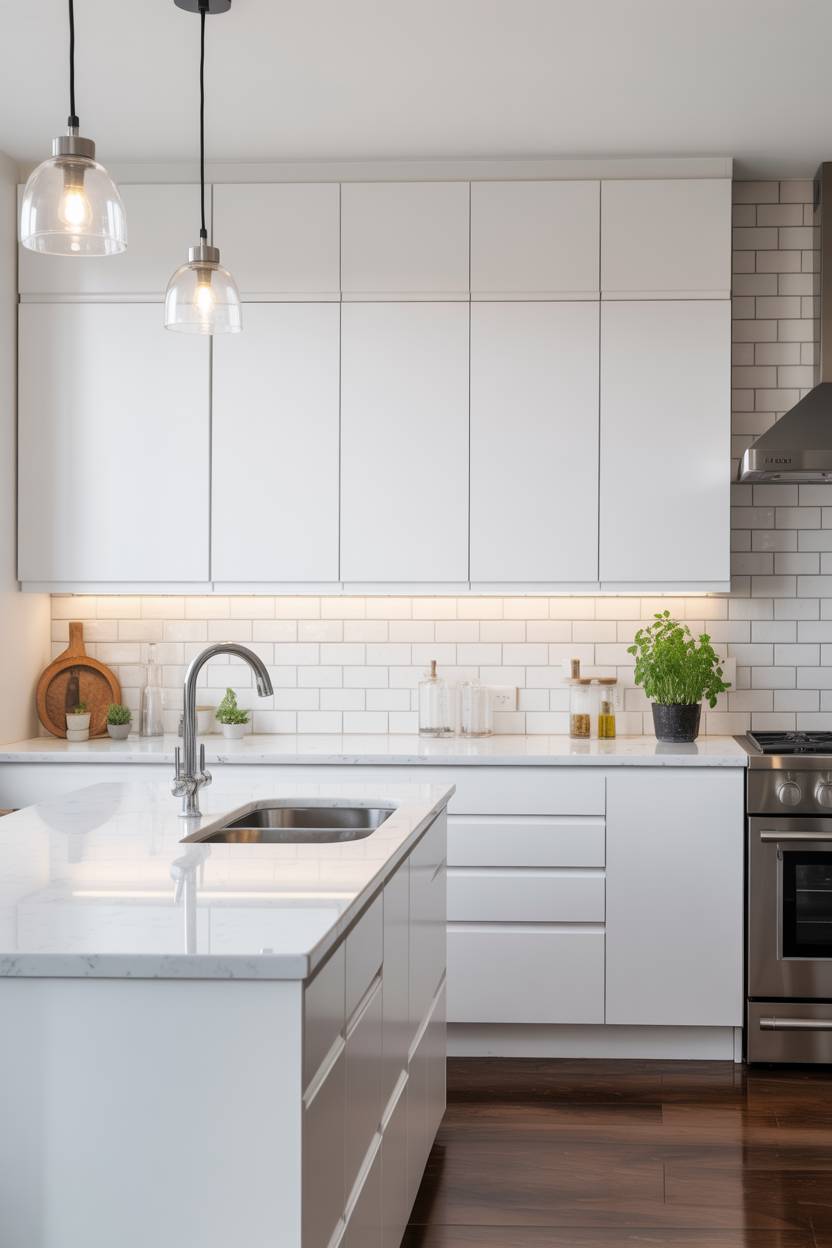
Functional beauty defines this kitchen, where every element serves a purpose while maintaining visual calm. Hidden hardware keeps cabinet faces smooth and uninterrupted. The monochromatic color scheme makes the space feel larger than its actual footprint.
This design proves that minimalism doesn’t mean sterile. The subtle variations in white tones add depth and interest. Natural light from hidden sources illuminates work surfaces effectively while maintaining the clean aesthetic.
Maximalist Showcase Rooms
Bohemian Maximalist Bedroom
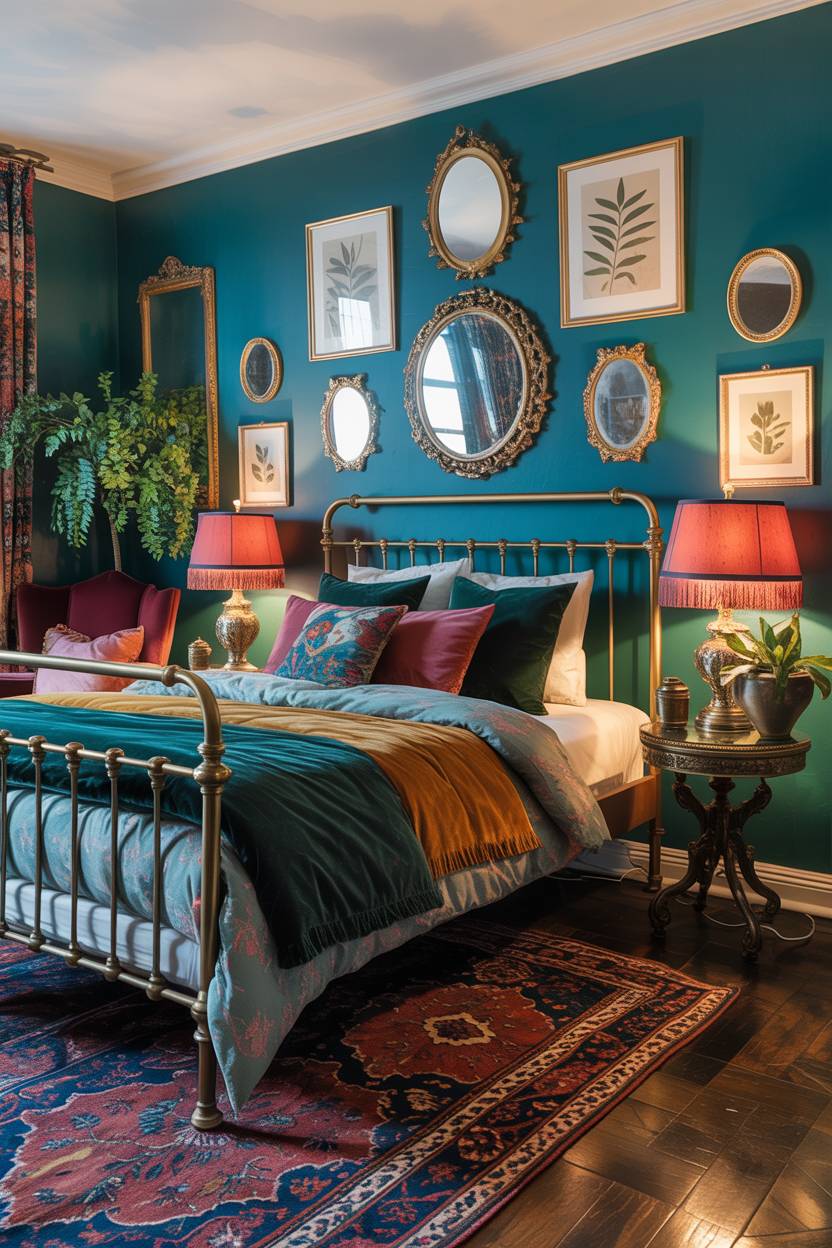
This personality-filled space shows how colors, patterns, and textures create a cozy, expressive retreat. The deep wall color provides a sophisticated backdrop for layered textiles and varied accessories. Each element tells part of the owner’s story.
The magic happens in the layering—patterns that shouldn’t work together create harmony through shared colors. Textures from smooth brass to nubby wool add tactile interest. The abundance feels curated rather than cluttered because everything serves the overall vision.
Eclectic Maximalist Dining Room
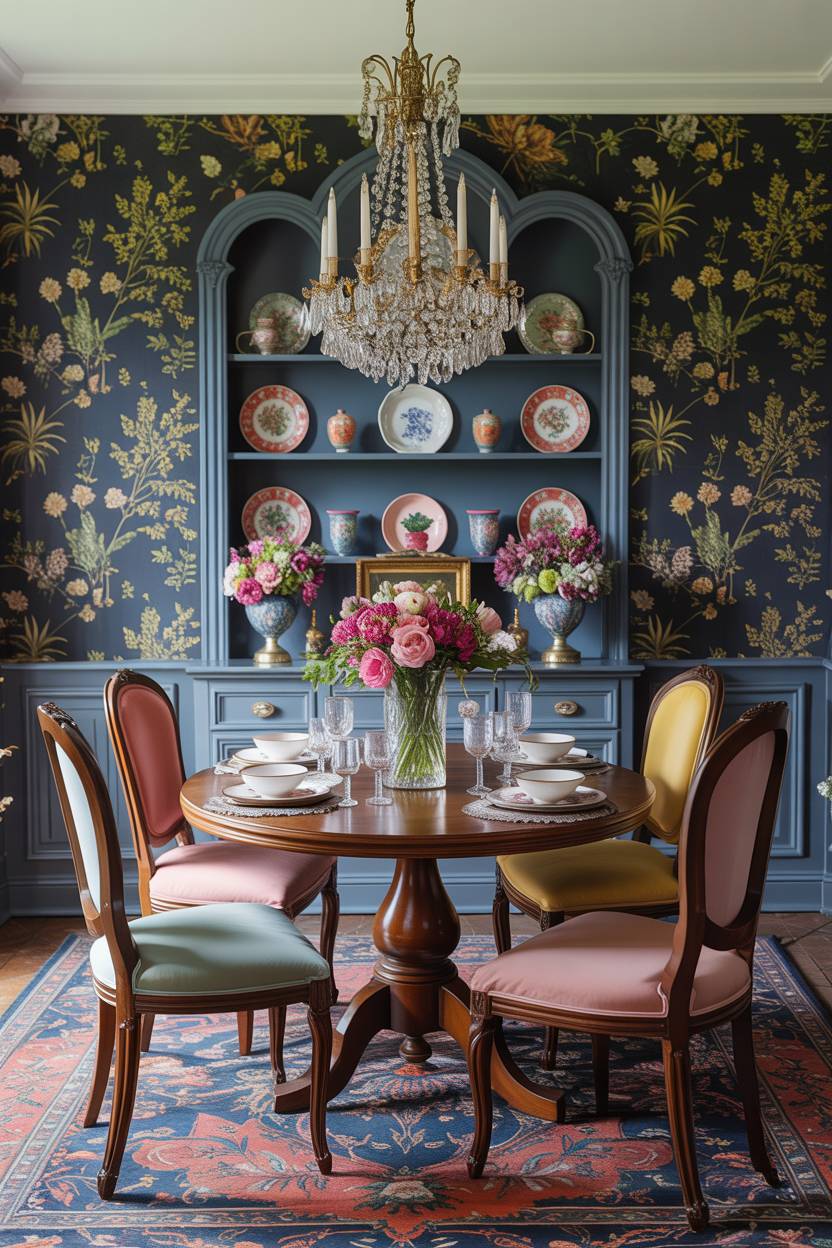
This conversation-starting space demonstrates how each element can tell a story while creating visual interest. The bold wallpaper sets a dramatic stage for varied furniture pieces that look collected over time rather than purchased as a set.
The beauty lies in the unexpected combinations—formal crystal with casual ceramics, antique wood with contemporary flowers. The gallery wall creates a personal museum that sparks conversation and reveals the owner’s interests and travels.
Balanced Blend Inspirations
Contemporary Fusion Living Room
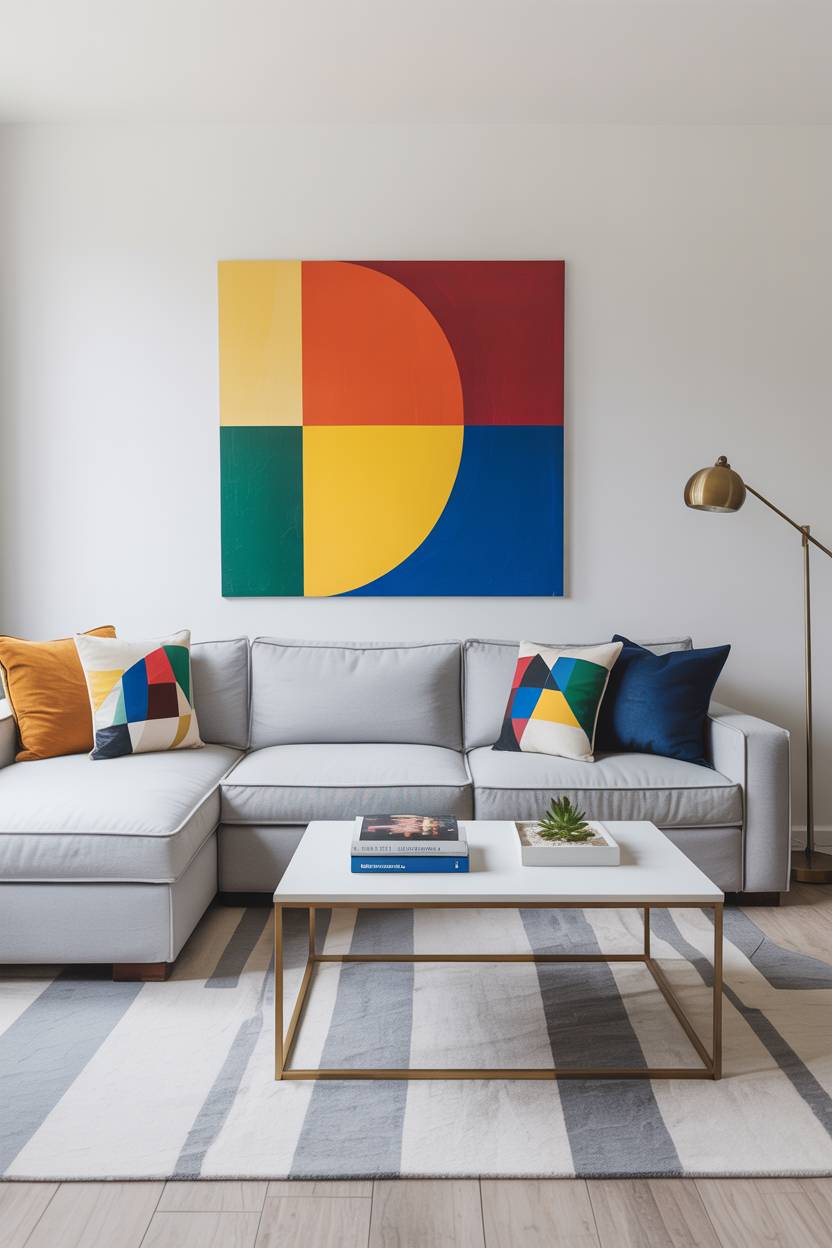
This space perfectly marries minimalist structure with maximalist personality touches. The neutral foundation provides calm stability while colorful accents add warmth and interest. The balance feels effortless and intentional.
The success comes from restraint—enough pattern and color to feel personal without overwhelming the clean foundation. Each maximalist element earns its place through beauty or function, maintaining the minimalist principle of purposeful design.
Sophisticated Mixed-Style Bedroom
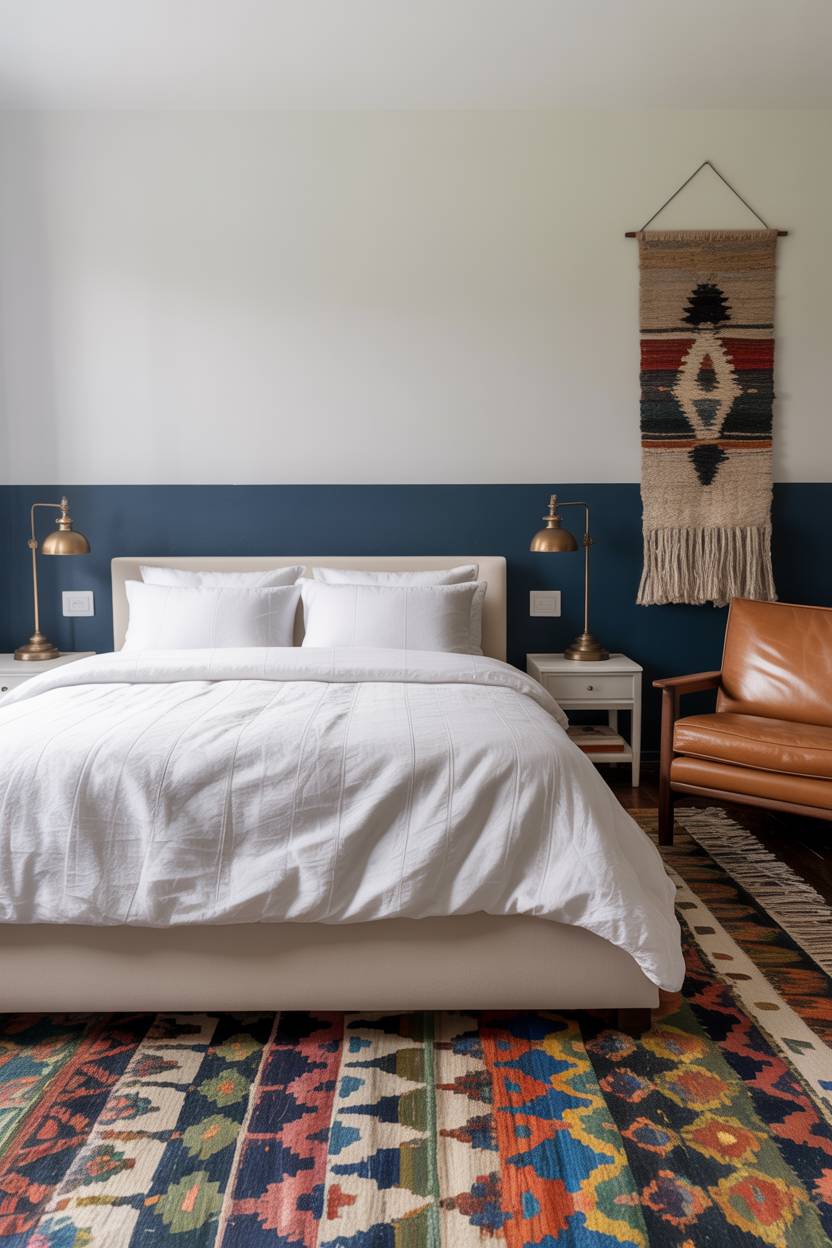
This example demonstrates how strategic maximalist additions can warm up minimalist foundations without sacrificing serenity. The accent wall adds drama while maintaining sophistication. Textural elements bring warmth without visual clutter.
The bedroom maintains its restful purpose while expressing personality through carefully chosen elements. The color palette remains limited but richer than pure minimalism, creating a space that feels both calm and personally meaningful.
Conclusion
The choice between minimalism vs maximalism isn’t about right or wrong—it’s about what makes you feel at home. Some people find peace in spare, uncluttered spaces. Others need the warmth and stimulation of abundant color and pattern.
Your perfect space might combine elements from both approaches. Start with understanding your lifestyle needs and personal preferences. Consider how you live in your space, not just how you think it should look.
Remember that great design evolves. You don’t need to transform your entire home overnight. Begin with small changes that move you toward your vision. Add or subtract elements as your needs and tastes develop.
Most importantly, create spaces that make you happy. Whether that means embracing minimalist serenity, maximalist abundance, or a thoughtful blend of approaches, your home should reflect who you are and support how you want to live.

